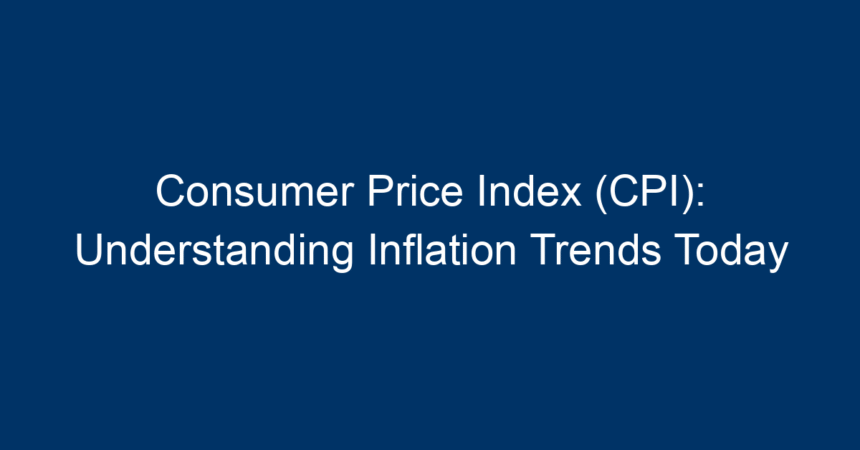In today’s rapidly evolving economic landscape, understanding the Consumer Price Index (CPI) is essential for consumers, investors, and policymakers alike. The CPI serves as a vital indicator of inflation, reflecting changes in the price level of a basket of goods and services typically purchased by households. With rising costs impacting daily life—from groceries to housing—grasping the nuances of the CPI can empower individuals and businesses to make informed financial decisions. This article delves into the intricacies of the Consumer Price Index, explores its implications for inflation trends, and offers actionable insights for navigating these economic waters.
What is the Consumer Price Index (CPI)?
The Consumer Price Index (CPI) measures the average change over time in the prices paid by urban consumers for a multitude of goods and services. It’s constructed by collecting data on the prices of various items, from food and clothing to medical care and transportation. The Bureau of Labor Statistics (BLS) in the United States publishes the CPI monthly, making it a critical tool for analyzing inflation.
Components of the CPI
The CPI encompasses several key categories:
-
Food and Beverages: This section accounts for consumer spending on groceries, dining out, and non-alcoholic beverages.
-
Housing: Housing costs make up a significant portion of the CPI, covering rents, mortgage costs, and utility bills.
-
Transportation: Prices for vehicles, fuel, and public transportation fall under this category.
-
Medical Care: It includes health insurance, hospital services, and medications.
-
Recreation: This area covers expenses related to entertainment, such as movies, hobbies, and cultural events.
- Education and Communication: Tuition fees, textbooks, and communication devices are included in this segment.
Each category is assigned a specific weight based on consumer spending patterns, which helps reflect the overall price changes effectively.
How is the CPI Calculated?
The calculation of the Consumer Price Index (CPI) involves several steps:
-
Selection of Items: A representative basket of goods and services is chosen based on consumer expenditure surveys.
-
Price Collection: Data collectors gather price information monthly or yearly for the selected items.
-
Calculation of Price Change: The price changes of the items in the basket are tracked over time.
-
Aggregation: The price changes are weighted according to the importance of each item in the average consumer’s spending.
- Index Creation: The resulting numbers are transformed into an index, where a base year is set to 100, allowing for straightforward comparisons over time.
Understanding Inflation Through CPI
Inflation essentially refers to the overall increase in prices and a decrease in the purchasing power of money. When the CPI rises, it indicates that consumers are paying more for goods and services, signaling inflation.
Types of Inflation
-
Demand-Pull Inflation: This occurs when demand for goods and services exceeds supply, pushing prices up.
-
Cost-Push Inflation: This happens when the costs of production increase—often due to higher wages or raw material costs—resulting in increased prices.
- Built-In Inflation: This is driven by the expectation of future inflation, leading businesses to raise prices proactively.
Understanding these types of inflation is crucial for interpreting CPI data and its implications for the economy.
Current Inflation Trends and CPI Analysis
As of the latest reports, inflation trends have shown fluctuations that can be attributed to various factors, including:
-
Pandemic Aftereffects: The COVID-19 pandemic triggered supply chain disruptions, leading to increased costs for many goods and services.
-
Energy Prices: Fluctuations in oil prices significantly affect transportation and shipping costs, which, in turn, impact the overall CPI.
- Labor Market Trends: Increased wages can drive cost-push inflation, affecting how businesses adjust their pricing strategies.
In analyzing current CPI data, it’s evident that inflation impacts different sectors unevenly. For example, while energy and food prices may surge, other categories may see stagnant or declining prices.
The Importance of CPI for Consumers and Investors
For Consumers
Understanding the Consumer Price Index (CPI) enables consumers to plan their finances more effectively. By monitoring CPI trends, individuals can:
-
Adjust Budgets: Allocate funds more accurately for essentials and discretionary spending.
-
Evaluate Purchasing Power: Assess how far their money will go in the future based on current and projected inflation trends.
- Make Informed Decisions: Choose when to buy larger items like homes or cars based on anticipated price changes.
For Investors
Investors must also pay close attention to CPI data as it influences economic policies and market conditions. Key benefits for investors include:
-
Inflation Hedge: Understanding inflation trends helps in identifying investment opportunities that may yield returns that outpace inflation.
-
Asset Allocation: Investors can adjust their portfolios to include assets that perform better during inflationary periods, like commodities or real estate.
- Market Timing: By monitoring CPI, investors can make strategic decisions about when to enter or exit markets based on predicted economic shifts.
Actionable Insights for Navigating CPI Trends
-
Stay Informed: Regularly review CPI reports released by the Bureau of Labor Statistics to understand price changes in different sectors.
-
Budget Wisely: Use CPI data to adjust personal budgets in order to accommodate rising costs.
-
Diversify Investments: Consider diversifying investments to include assets that traditionally perform well during inflation, such as real estate and commodities.
- Plan for the Future: Be proactive in financial planning, anticipating inflation impact on savings and long-term goals.
Conclusion
Understanding the Consumer Price Index (CPI) is vital for anyone looking to navigate today’s complex economic landscape. This key indicator provides insights into inflation trends and influences various financial decisions. By staying informed and adapting strategies in response to CPI fluctuations, consumers and investors can better manage their finances in uncertain times. As inflation remains a critical concern, leveraging CPI knowledge can empower individuals and businesses alike to make sound economic choices that safeguard their financial futures.




